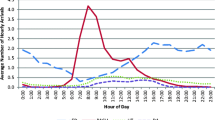Abstract
Hospital inpatient bed capacity might be better described as evolved than planned. At least two challenges lead to this behaviour: different views of patient demand implied by different data sets in a hospital and limited use of scientific methods for capacity estimation. In this paper, we statistically examine four distinct hospital inpatient data sets for internal consistency and potential usefulness for estimating true patient bed demand. We conclude that posterior financial data, billing data, rather than the census data commonly relied upon, yields true hospital bed demand. Subsequently, a capacity planning tool, based upon queuing theory and financial data only, is developed. The delivery mechanism is an Excel spreadsheet. One adjusts input parameters including patient volume and mix and instantaneously monitors the effect on bed needs across multiple levels of care. A case study from a major hospital in Phoenix, Arizona, USA is used throughout to demonstrate the methodologies.











Similar content being viewed by others
References
Bagust A, Place M and Posnett JW (1999). Dynamics of bed use in accommodating emergency admissions: Stochastic simulation model. Br Med J 319: 155–158.
Bretthauer KM and Coté MJ (1998). A model for planning resource requirements in health care organizations. Decis Sci 29: 243–270.
Cochran JK and Bharti A (2006a). A multi-stage stochastic methodology for whole hospital bed planning under peak loading. Int J Ind Syst Eng 1: 8–36.
Cochran JK and Bharti A (2006b). Stochastic bed balancing of an obstetrics hospital. Health Care Mngt Sci 9: 31–45.
Costa AX, Ridley SA, Shahani AK, Harper PR, DeSenna V and Nielsen MS (2003). Mathematical modelling and simulation for planning critical care capacity. Anaesthesia 58: 320–327.
Elbeyli S and Krishnan P (2000). In-patient flow analysis using ProModel™ simulation package. FREC Staff Paper 3-6, University of Delaware.
Gorunescu F, McClean SI and Millard PH (2002). Using a queuing model to help plan bed allocation in a department of geriatric medicine. Health Care Mngt Sci 5: 307–312.
Green LV (2002). How many hospital beds? Inquiry—Blue Cross and Blue Shield Assoc 39: 400–413.
Gross D and Harris CM (1998). Fundamentals of Queuing Theory, 3rd edn. Wiley: New York.
Harper PR and Shahani AK (2002). Modeling for the planning and management of bed capacities in hospitals. J Opl Res Soc 53: 11–18.
Ivatts S and Millard P (2002). Health care modeling—why should we try? Br J Health Care Mngt 8: 218–222.
Kim S, Horowitz I, Young KK and Buckley TA (1999). Analysis of capacity management of the intensive care unit in a hospital. Eur J Opns Res 115: 36–46.
Kim S, Horowitz I, Young KK and Buckley TA (2000). Flexible bed allocation and performance in the intensive care unit. J Opns Mngt 18: 427–443.
Lapierre SD, Goldsman D, Cochran R and DuBow J (1999). Bed allocation techniques based on census data. Socio-Econ Plann Sci 33: 25–38.
Nguyen JM, Six P, Antonioli D, Glemain P, Potel G, Lombrail P and Le Beux P (2005). A simple method to optimize beds capacity. Int J Med Inform 74: 39–49.
Ridge JC, Jones SK, Nielsen MS and Shahani AK (1998). Capacity planning for intensive care units. Eur J Opns Res 105: 346–355.
Roche KT (2005). A queuing and simulation-based approach to non-linear hospital bed planning. MS thesis, Ira A. Fulton School of Engineering, Arizona State University.
Schmida JT (2000). The need for flexible beds in the 21st century. Healthcare Strat Mngt 18: 16–18.
Seymour DG (2001). Health care modelling and clinical practice: Theoretical exercise or practical tool? Health Care Mngt Sci 4: 7–12.
Standridge CR (1999). A tutorial on simulation in health care: applications and issues. In: Farrington PA, Nembhard HB, Sturrock DT and Evans GW (eds). Proceedings of the 1999 Winter Simulation Conference. Society of Computer Simulation International (SCS): San Dego, SCS. pp 49–55.
Vassilacopoulos G (1985). A simulation model for bed allocation to hospital inpatient departments. Simulation 45: 233–241.
Walczak S, Pofahl WE and Scorpio RJ (2002). A decision support tool for allocating hospital bed resources and determining required acuity of care. Decis Supp Syst 34: 445–456.
Weber DO (2006). Queue fever, Part 2. Hospitals and Health Networks website: http://www.hospitalconnect.com/hhnmag/jsp/articledisplay.jsp?dcrpath=HHNMAG/PubsNewsArticle/data/2006May/060517HHN_Online_Weber&domain=HHNMAG, accessed 21 June 2006.
Acknowledgements
We wish to thank leadership at The Hospital for their support and interest. This work was funded in part by the Agency for Healthcare Research and Quality under Partnership in Patient Safety grant #HS015921-01 whose PI is Twila Burdick of Banner Health. We also thank two anonymous referees for valuable improvements to this manuscript.
Author information
Authors and Affiliations
Corresponding author
Rights and permissions
About this article
Cite this article
Cochran, J., Roche, K. A queuing-based decision support methodology to estimate hospital inpatient bed demand. J Oper Res Soc 59, 1471–1482 (2008). https://doi.org/10.1057/palgrave.jors.2602499
Received:
Accepted:
Published:
Issue Date:
DOI: https://doi.org/10.1057/palgrave.jors.2602499




